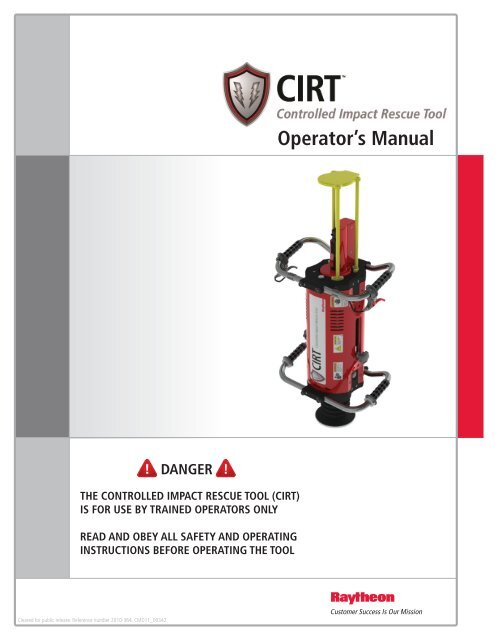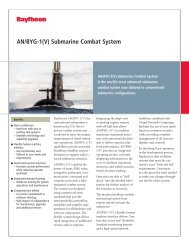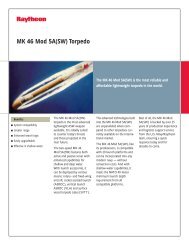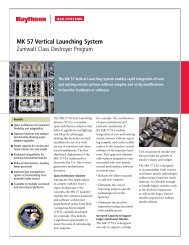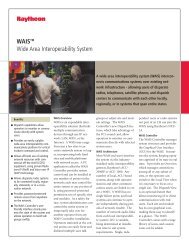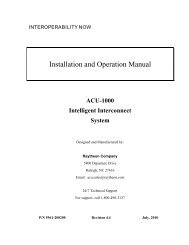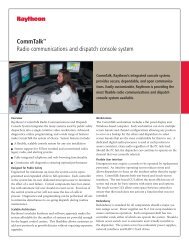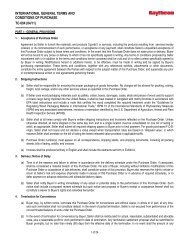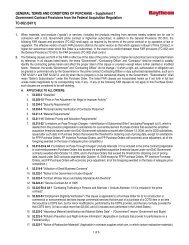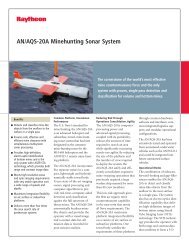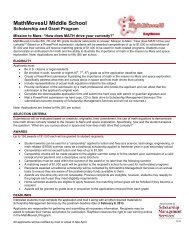Controlled Impact Rescue Tool (CIRT) Operator's Manual - Raytheon
Controlled Impact Rescue Tool (CIRT) Operator's Manual - Raytheon
Controlled Impact Rescue Tool (CIRT) Operator's Manual - Raytheon
Create successful ePaper yourself
Turn your PDF publications into a flip-book with our unique Google optimized e-Paper software.
Cleared for public release. Reference number 2010-364. CMD11_00342<br />
DANGER<br />
THE CONTROLLED IMPACT RESCUE TOOL (<strong>CIRT</strong>)<br />
IS FOR USE BY TRAINED OPERATORS ONLY<br />
READ AND OBEY ALL SAFETY AND OPERATING<br />
INSTRUCTIONS BEFORE OPERATING THE TOOL<br />
Operator’s <strong>Manual</strong>
________________________________________________________<br />
Acknowledgement<br />
The <strong>Controlled</strong> <strong>Impact</strong> <strong>Rescue</strong> <strong>Tool</strong>s (<strong>CIRT</strong>) was developed in cooperation with the<br />
US Department of Homeland Security, Science and Technology Directorate.<br />
________________________________________________________<br />
2
DANGER<br />
SAFETY WARNINGS_____________________________________<br />
DANGER<br />
THIS TOOL IS TO BE USED ONLY BY PROPERLY TRAINED<br />
OPERATORS. YOU MUST COMPLETE THE RAYTHEON <strong>CIRT</strong><br />
TRAINING PROGRAM BEFORE HANDLING, LOADING, OR<br />
OPERATING THIS TOOL. ATTEMPTING TO HANDLE OR<br />
OPERATE THIS TOOL WITHOUT PROPER TRAINING CAN<br />
RESULT IN SERIOUS INJURY OR EVEN DEATH TO THE TOOL<br />
OPERATORS AND BYSTANDERS.<br />
DANGER<br />
SAFETY WARNINGS_____________________________________<br />
3
SAFETY INSTRUCTIONS__________________________________ CAUTION<br />
Acceptable Materials<br />
The <strong>CIRT</strong> is suitable for use on the<br />
following materials only:<br />
� Reinforced Concrete walls and floors<br />
between 4” & 8” in thickness<br />
� Reinforced Concrete ceilings 5” thick<br />
or less<br />
Never use the <strong>CIRT</strong> on any other materials.<br />
Failure to follow these guidelines may damage<br />
the <strong>CIRT</strong> and cause serious injury to operators<br />
and bystanders.<br />
Unacceptable Materials<br />
Never use the <strong>CIRT</strong> on non-reinforced<br />
concrete. Failure to follow this could result in<br />
destabilization of the intended breach, damage<br />
to the <strong>CIRT</strong>, and/or injury to operators and<br />
bystanders.<br />
<strong>CIRT</strong> Load Safety<br />
1. Only use approved <strong>CIRT</strong> cartridges in<br />
the <strong>CIRT</strong> tool. The use of any other<br />
cartridge is strictly prohibited and may<br />
damage the tool and cause serious injury<br />
to operators.<br />
2. Never, under any circumstances, store or<br />
transport the tool in a loaded condition.<br />
3. Always transport and store <strong>CIRT</strong><br />
charges in an approved container.<br />
Leave the charges in the container until<br />
ready for use. The storage container for<br />
the charges has been specially designed to<br />
preclude accidental discharge. It also<br />
protects the charges from contamination<br />
and damage, ensuring proper operation.<br />
Operating Area Safety<br />
1. Ensure the proper personal protective<br />
equipment is being worn by operators<br />
and any bystanders as necessary. Loud<br />
noise and flying debris from the operation<br />
of the <strong>CIRT</strong> has the potential to injure<br />
operators as well as others nearby. Ensure<br />
everyone near the operating area is<br />
adequately protected.<br />
2. Keep the breaching area clear of<br />
unnecessary bystanders, equipment, and<br />
materials that may interfere with safe<br />
operation of the <strong>CIRT</strong>. Operating the<br />
<strong>CIRT</strong> in an area with excessive debris,<br />
obstacles, and unnecessary personnel may<br />
affect your ability to handle and operate<br />
the tool safely.<br />
3. Never operate the <strong>CIRT</strong> around<br />
potentially flammable or explosive<br />
materials or conditions. The combustion<br />
products vented by the <strong>CIRT</strong> have the<br />
potential for igniting flammable materials<br />
nearby. Take this into consideration when<br />
selecting and preparing an area for a<br />
breach.<br />
<strong>Tool</strong> Handling Safety<br />
1. Always be sure the <strong>CIRT</strong> is operating<br />
properly before attempting to use it.<br />
Follow the Functionality Test outlined in<br />
the Operating Instructions section on<br />
page 7 of this manual prior to use.<br />
2. Do not load the tool until you are ready<br />
to operate it. Only load the tool once it<br />
has been set up in the immediate vicinity<br />
of where it is to be operated. If use is<br />
aborted after the cartridge is loaded,<br />
unload the tool before continuing. Do<br />
not store the <strong>CIRT</strong> loaded. Leaving the<br />
tool unattended while loaded may lead to<br />
accidental discharge by other operators or<br />
bystanders with the potential for injury.<br />
3. Once the tool is loaded do not place any<br />
body part or foreign object in or near<br />
the opening for the <strong>Impact</strong>or. Failure to<br />
obey this could lead to serious injury<br />
and/or damage to the <strong>CIRT</strong>.<br />
SAFETY INSTRUCTIONS__________________________________ CAUTION<br />
4
CAUTION<br />
SAFETY INSTRUCTIONS__________________________________<br />
4. Do not allow anyone who has not been<br />
trained operate the <strong>CIRT</strong>. This manual<br />
is not designed to fully train operators of<br />
the <strong>CIRT</strong>. All operators must complete the<br />
approved operator training before<br />
operating the tool.<br />
5. Using the <strong>CIRT</strong> in a poorly ventilated<br />
area, cleaning the <strong>CIRT</strong>, or handling the<br />
cartridges may result in exposure to<br />
harmful substances. Have adequate<br />
ventilation at all times when operating<br />
or cleaning the <strong>CIRT</strong> and wash<br />
thoroughly after exposure.<br />
Misfire Procedure<br />
If the <strong>CIRT</strong> does not fire after pulling the<br />
triggers, continue to stand in the firing<br />
position with the tool firmly pressed against<br />
the work surface for a minimum of 5<br />
seconds.<br />
After 5 seconds have passed, return the tool<br />
to a safe loading position and eject the<br />
misfired cartridge. Immediately place the<br />
cartridge in a safe location away from<br />
flammable materials and other cartridges.<br />
Placing it in a bucket of water or other nonflammable<br />
liquid is preferable prior to<br />
disposal.<br />
Ensure the Receiver Safety Lever was in the<br />
“Fire” position.<br />
Load a new cartridge in the <strong>CIRT</strong> and<br />
attempt to operate it again. If a second<br />
cartridge also misfires, discontinue use of<br />
the tool until a cause can be determined.<br />
Warning<br />
Inspect tool before every use. STOP USE if<br />
any component or fastener becomes loose or<br />
is missing<br />
CAUTION<br />
SAFETY INSTRUCTIONS__________________________________<br />
5
<strong>CIRT</strong> OVERVIEW_________________________________________<br />
<strong>CIRT</strong> OVERVIEW_________________________________________<br />
6
OPERATING INSTRUCTIONS______________________________<br />
DANGER<br />
Whenever approaching the tool for any<br />
reason, always begin by opening the bolt and<br />
visually ensuring that no cartridge is present.<br />
Functionality Test<br />
1. After checking to be sure that the <strong>CIRT</strong> is<br />
not loaded, close the Receiver Bolt<br />
without inserting a cartridge and engage<br />
the Receiver Safety Lever into the “Fire”<br />
position.<br />
2. Depress the Secondary Trigger, and release<br />
it. Ensure it moves freely and returns fully.<br />
If it does not move smoothly or return fully<br />
discontinue use of the tool.<br />
3. Depress the Secondary Trigger and hold it<br />
in place. Now depress the Firing Trigger,<br />
listening carefully for operation of the<br />
firing pin. The firing pin should release<br />
with an audible click. If the firing pin does<br />
not operate when both triggers are fully<br />
depressed discontinue use of the tool.<br />
Refer to the Firing Cable Adjustment<br />
Procedure on page 19 before attempting to<br />
use the <strong>CIRT</strong>.<br />
4. Release both triggers, ensuring that the<br />
Firing Trigger moves smoothly and returns<br />
fully. If it does not discontinue use of the<br />
tool immediately.<br />
5. Open the Bolt to reset the firing pin and<br />
close it again without inserting a<br />
cartridge. With the Secondary Trigger not<br />
depressed attempt to depress only the<br />
Firing Trigger. Listen for the firing pin to<br />
release. If the Firing Trigger alone is able<br />
to release the firing pin without the<br />
Secondary Trigger being depressed,<br />
discontinue use of the tool immediately.<br />
Refer to the Firing Cable Adjustment<br />
Procedure on page 19 before attempting to<br />
use the <strong>CIRT</strong>.<br />
6. With the Bolt still closed in the firing<br />
position and no cartridge in the chamber,<br />
move the Receiver Safety Lever to the<br />
“Safe” position.<br />
7. Depress the Secondary Trigger and hold it<br />
in place. Now depress the Firing Trigger,<br />
listening carefully for operation of the<br />
firing pin. The firing pin should not<br />
operate. This tests the operation of the<br />
Receiver Safety Lever. If the firing pin<br />
operates when both triggers are depressed<br />
with the receiver safety mechanism in the<br />
“Safe” position discontinue use of the tool<br />
immediately.<br />
8. Release both triggers, ensuring that the<br />
Firing Trigger moves smoothly and returns<br />
fully. If it does not discontinue use of the<br />
tool immediately.<br />
9. Open the Receiver Bolt. Using the<br />
<strong>Impact</strong>or Reset Handles on the sides of the<br />
<strong>CIRT</strong> reset the <strong>Impact</strong>or into the upper<br />
(ready) position. Ensure that it moves<br />
freely into position and remains there after<br />
handles have been released. If it does not<br />
move smoothly or does not remain<br />
unassisted in the ready position, consult the<br />
Troubleshooting Chart on page 9.<br />
After the <strong>CIRT</strong> has passed the Functionality<br />
Test it is ready to be used. If the <strong>CIRT</strong> does<br />
not pass the test even after consulting the<br />
Troubleshooting Chart and Firing Cable<br />
Adjustment Procedures discontinue use of<br />
the tool and contact your sales<br />
representative.<br />
OPERATING INSTRUCTIONS______________________________<br />
7
OPERATING INSTRUCTIONS______________________________<br />
DANGER<br />
Before operating the <strong>CIRT</strong> ensure that all<br />
operators and bystanders are wearing proper<br />
Personal Protective Equipment (PPE) and are<br />
notified that you will be firing the <strong>CIRT</strong><br />
<strong>CIRT</strong> Operation<br />
1. With the <strong>CIRT</strong> in a safe loading position,<br />
move the Receiver Safety Lever to the<br />
“Safe” position. Open the Receiver Bolt.<br />
2. Reset the <strong>Impact</strong>or to the top of the stroke<br />
using the <strong>Impact</strong>or Reset Handles on the<br />
side of the <strong>CIRT</strong>. Ensure the handles<br />
return to their starting point at the bottom<br />
of the stroke.<br />
3. Insert an appropriate <strong>CIRT</strong> cartridge into<br />
the Receiver. Close the Bolt.<br />
4. Once both operators are ready and the<br />
location of the breach has been decided<br />
move the Receiver Safety Lever to the<br />
“Fire” position.<br />
5. Pick up the <strong>CIRT</strong> tool by the front and rear<br />
handles. It is important that both operators<br />
grasp only the handles with no fingers<br />
above or touching the triggers until the<br />
<strong>CIRT</strong> is in position.<br />
6. Place the tool against the wall for the<br />
breach. Ensure both operators have an<br />
adequate stance and grip for the expected<br />
recoil of the <strong>CIRT</strong>.<br />
7. Once both operators are ready, the operator<br />
on the left side of the tool may actuate the<br />
black Secondary Trigger, thereby<br />
disengaging the lockout on the Firing<br />
Trigger. The secondary operator should<br />
notify the firing trigger operator that the<br />
trigger is fully depressed.<br />
8. Once the firing operator has decided that<br />
everything is properly in position, and has<br />
determined that the secondary operator is<br />
ready, they may then actuate the Firing<br />
Trigger. This will discharge the <strong>CIRT</strong>.<br />
9. Do not attempt to keep the <strong>CIRT</strong> in<br />
contact with the wall while discharging.<br />
Make sure neither operator, or any<br />
bystanders, are standing in the expected<br />
recoil path of the <strong>CIRT</strong>. The recoil force<br />
of the <strong>CIRT</strong> is too high to be forcibly<br />
stopped. Operators should only control the<br />
path of the <strong>CIRT</strong> during recoil.<br />
10. Once the <strong>CIRT</strong> has been fired, return it to a<br />
safe loading position. Open the Bolt to<br />
eject the shell and keep it open.<br />
11. This completes a full firing sequence of the<br />
<strong>CIRT</strong>. Repeat steps 2-10 until desired<br />
breach size has been achieved.<br />
Post-Breaching Inspection and Storage<br />
Instructions<br />
It is important to properly inspect and store the<br />
<strong>CIRT</strong> after each use to ensure it will remain in<br />
good working order until the next deployment.<br />
1. After each deployment of the <strong>CIRT</strong><br />
inspect the entire unit for obvious signs<br />
of damage. Closely inspect the covers,<br />
handles, Safety Cage, Receiver, triggers,<br />
and any other visible components to see<br />
that they are free from damage and<br />
lodged debris.<br />
2. Clean the <strong>CIRT</strong> tool in accordance with<br />
the procedures outlined in the<br />
Maintenance and Cleaning Instructions<br />
on page 10.<br />
3. Perform the Functionality Test per the<br />
instructions on page 7 prior to storing the<br />
<strong>CIRT</strong> to ensure it is still fully<br />
functioning.<br />
4. Every 6 months of continuous storage the<br />
<strong>CIRT</strong> should be inspected and cleaned<br />
again to ensure continued reliability and<br />
readiness.<br />
OPERATING INSTRUCTIONS______________________________<br />
8
TROUBLESHOOTING_____________________________________<br />
<strong>CIRT</strong> Troubleshooting<br />
Problem Possible Reason Solution<br />
<strong>CIRT</strong> Fails to Fire<br />
Piston Head Difficult<br />
to Reset<br />
Insufficient<br />
Penetration into<br />
Target Material<br />
Excessive<br />
Penetration into<br />
Target Material<br />
Excessive Recoil<br />
No Round Loaded Ensure there is a <strong>CIRT</strong> cartridge loaded in the tool<br />
Receiver Safety Lever Engaged<br />
Cartridge Misfire<br />
Trigger Safety Catch Failure<br />
Piston/<strong>Impact</strong>or Assembly Dirty<br />
Piston/<strong>Impact</strong>or Assembly<br />
Damaged<br />
Target Material Too Hard<br />
Piston Not Fully Reset<br />
Target Material Too Soft<br />
Target Material Too Hard<br />
Damage to Damping Mechanism<br />
Ensure the Receiver Safety Lever is set to the "Fire"<br />
position<br />
Follow the "Misfire Procedure" in the Safety Instructions<br />
on page 5<br />
Ensure the Trigger Safety Mechanism is operating<br />
properly as outlined in the Functionality Test on page 7<br />
Remove Piston/<strong>Impact</strong>or assembly and clean.<br />
Reassemble and recheck<br />
Remove and replace Piston/<strong>Impact</strong>or assembly<br />
Ensure the <strong>CIRT</strong> is being used only on approved target<br />
materials, listed in the Safety Instructions on page 4<br />
Fully reset before each firing. Ensure the ball detents<br />
are holding the piston in the firing position.<br />
Ensure the <strong>CIRT</strong> is being used only on approved target<br />
materials, listed in the Safety Instructions on page 4<br />
Ensure the <strong>CIRT</strong> is being used only on approved target<br />
materials, listed in the Safety Instructions on page 4<br />
Discontinue use of the <strong>CIRT</strong> Immediately and contact<br />
your sales representative<br />
If after performing the checks described in the troubleshooting table the <strong>CIRT</strong> does not perform to<br />
specifications, or if you discover excessive wear or damage to any parts not covered in the<br />
maintenance instructions, discontinue use of the tool immediately and contact your sales<br />
representative for additional assistance.<br />
Record any <strong>CIRT</strong> malfunctions and the corrective action taken in the <strong>CIRT</strong> Maintenance Log (page 22.)<br />
TROUBLESHOOTING_____________________________________<br />
9
MAINTENANCE AND CLEANING__________________________<br />
Cleaning Instructions – Every Use<br />
Ensure that you are wearing adequate<br />
personal protective equipment for the tools<br />
and cleaning products you are using.<br />
Foot, <strong>Impact</strong>or Guide Sleeve<br />
1. Ensure the <strong>Impact</strong>or is at the bottom of<br />
the stroke. If it has been reset, place the<br />
<strong>CIRT</strong> on the ground in the vertical<br />
position and tap the Foot on the ground to<br />
dislodge the <strong>Impact</strong>or from the internal<br />
retention mechanism.<br />
2. Remove the Foot as outlined in Section 1<br />
of the Maintenance Procedures.<br />
a. Check the area inside the Foot for<br />
excessive dirt and debris.<br />
b. Clean the foot using damp towel<br />
and dry thoroughly.<br />
3. Remove the <strong>Impact</strong>or Guide Sleeve as<br />
outlined in Section 2 of the Maintenance<br />
Procedures.<br />
a. Clean the Guide Sleeve using<br />
scour pad, wipe clean and dry<br />
thoroughly.<br />
DANGER<br />
IMPROPERLY MAINTAINED TOOLS CAN CAUSE SERIOUS INJURIES TO<br />
TOOL OPERATORS AND BYSTANDERS.<br />
FOLLOW ALL INSTRUCTIONS REGARDING PROPER MAINTENANCE<br />
PROCEDURES AND INTERVALS FOR THE <strong>CIRT</strong> TOOL.<br />
ALWAYS MAKE SURE THE <strong>CIRT</strong> IS NOT LOADED BEFORE PERFORMING<br />
ANY SERVICE OR REPAIR.<br />
<strong>Impact</strong>or Assembly and Inner Chamber<br />
4. Remove the <strong>Impact</strong>or Assembly as<br />
outlined in Section 3 of the Maintenance<br />
Procedures.<br />
a. Inspect <strong>Impact</strong>or Assembly<br />
(Piston Head, Piston Ring, Main<br />
Bumpers, and Trolley) Replace as<br />
needed.<br />
b. Clean entire <strong>Impact</strong>or using scour<br />
pad and wipe dry.<br />
c. Inside of Chamber – Clean with<br />
cleaning brush and dry<br />
thoroughly.<br />
5. Reinstall the <strong>Impact</strong>or Assembly into<br />
chamber as outlined in section 3 of the<br />
maintenance procedures.<br />
6. Install the Guide Sleeve as outlined in<br />
Section 2 of the maintenance procedures.<br />
7. Reinstall the Foot as outlined in Section 1<br />
of the maintenance procedures<br />
MAINTENANCE AND CLEANING__________________________<br />
10
MAINTENANCE AND CLEANING__________________________<br />
Main Body and Side Rails<br />
8. Remove the Main Body Covers as<br />
outlined in Section 4 of the Maintenance<br />
Procedures.<br />
a. Wipe clean and dry thoroughly.<br />
You will not be able to remove<br />
carbon scarring.<br />
9. Clean the Main Body of the <strong>CIRT</strong>.<br />
Blow the area out thoroughly with<br />
compressed air.<br />
a. Inspect the Main Body of the<br />
<strong>CIRT</strong> (Springs, Dampers, Cables,<br />
Bearings)<br />
10. Remove ONE Side Rail as directed in<br />
Section 5 of the Maintenance Procedures<br />
a. Clean Slide Rail mechanism with<br />
scour pad and wipe dry.<br />
b. Lightly oil (3-4 drops) inside<br />
track and move Slide Mechanism<br />
to spread thoroughly.<br />
c. Wipe excess oil.<br />
11. Reinstall Side Rail<br />
12. Repeat steps 3 and 4 for remaining rail<br />
13. Reinstall the Main Body Covers as<br />
directed in Section 4 of the Maintenance<br />
Procedures<br />
Receiver Mechanism<br />
14. Disassemble and clean the Receiver<br />
mechanism as directed in Section 6 of the<br />
Maintenance Procedures.<br />
If the <strong>CIRT</strong> is subjected to environmental<br />
conditions outside of normal usage in-depth<br />
cleaning of the tool is necessary. These<br />
conditions include, but are not limited to, use<br />
in a sandy environment and immersion in<br />
mud or water.<br />
MAINTENANCE AND CLEANING__________________________<br />
11
MAINTENANCE PROCEDURES__________________________<br />
Required <strong>Tool</strong>s for Maintenance:<br />
• Spanner Wrench, 1/4” Pin, Adjustable • Hex Driver, Ball End, 1/4” with screw-<br />
from 2” to 4-3/4”<br />
holder tip<br />
• Hex Driver, Ball End, 3/16” • Hex Driver, Ball End, 5/32”<br />
• Wrench, 1-1/4”, Open Ended • Screw Driver, Flat Tip, ¼”<br />
• Dead-Blow Hammer • Screw Driver, Phillips Head, #2<br />
• Bearing Extraction <strong>Tool</strong> TD93DW84 • Metal Hammer<br />
• Pin Punch, 3/16” diameter<br />
Additional Items Required:<br />
• Remington “Rem Action” Cleaner • Thread Locking Compound, Medium<br />
• Remington “Rem Oil” Lubricant • Compressed air<br />
• Anti-seize compound<br />
<strong>CIRT</strong> Maintenance Procedures<br />
Before performing any maintenance<br />
operation open the Bolt and verify that the<br />
<strong>CIRT</strong> is not loaded. Using two people place<br />
the <strong>CIRT</strong> horizontally on a sturdy work<br />
surface. Ensure you are wearing appropriate<br />
personal protective equipment for the tools<br />
you are using.<br />
Section 1 – Foot<br />
Removal and Reinstallation<br />
1. Remove the six (6) cap screws securing the<br />
Foot to the <strong>CIRT</strong> tool using the 3/16” hex<br />
driver (see Figure 1).<br />
2. To reinstall the Foot, line it up with the<br />
holes and tap it gently with the dead-blow<br />
hammer until it is seated against the front<br />
handle plate. Partially thread in all six (6)<br />
cap screws before tightening them in any<br />
order.<br />
Section 2 – <strong>Impact</strong>or Guide Sleeve<br />
Removal<br />
1. Remove the Foot as outlined in Section 1 –<br />
Foot.<br />
Figure 1 – Foot Removal<br />
Figure 2 – <strong>Impact</strong>or Guide Sleeve Removal<br />
MAINTENANCE PROCEDURES____________________________<br />
12
MAINTENANCE PROCEDURES____________________________<br />
2. Use the spanner wrench to remove the<br />
<strong>Impact</strong>or Guide Sleeve (see Figure 2). The<br />
sleeve unscrews counterclockwise from the<br />
<strong>Impact</strong>or Assembly Retaining Nut. A light<br />
tap from the dead-blow hammer on the<br />
spanner wrench may be necessary to<br />
disengage the collar.<br />
Reinstallation<br />
1. For reassembly, apply anti-seize compound<br />
to the threads and install the <strong>Impact</strong>or<br />
Guide Sleeve into the <strong>Impact</strong>or Assembly<br />
Retaining Nut while rotating clockwise<br />
until it is lightly seated. Use the spanner<br />
wrench to tighten. Several light taps from<br />
the dead-blow hammer on the spanner<br />
wrench may be necessary to fully secure<br />
the sleeve (see Figure 3).<br />
2. Reinstall the Foot as outlined in Section 1 –<br />
Foot.<br />
Section 3 –<strong>Impact</strong>or Assembly<br />
Removal<br />
1. Ensure the <strong>Impact</strong>or is at the bottom of the<br />
stroke. If it has been reset, place the <strong>CIRT</strong><br />
on the ground in the vertical loading<br />
position and tap the Foot on the ground to<br />
dislodge the <strong>Impact</strong>or from the internal<br />
retention mechanism.<br />
2. Remove the Foot and the <strong>Impact</strong>or Guide<br />
Sleeve as outlined in Sections 1 and 2.<br />
3. Remove the plugs covering the two (2)<br />
Piston Reset Screws and remove the screws<br />
with the 1/4” hex driver (see Figure 4).<br />
4. Using the spanner wrench, unscrew the<br />
<strong>Impact</strong>or Assembly Retaining Nut (see<br />
Figure 5). A light tap from the dead-blow<br />
hammer on the spanner wrench may be<br />
necessary to disengage the nut.<br />
5. Grasp the <strong>Impact</strong>or and slide the <strong>Impact</strong>or<br />
Assembly out of the tool (see Figure 6).<br />
Figure 3 – <strong>Impact</strong>or Guide Sleeve Reinstallation<br />
Figure 4 –Piston Reset Screws<br />
Figure 5 – <strong>Impact</strong>or Assembly Retaining Nut<br />
MAINTENANCE PROCEDURES____________________________<br />
13
MAINTENANCE PROCEDURES____________________________<br />
Disassembly<br />
1. With the <strong>Impact</strong>or Assembly removed from<br />
the <strong>CIRT</strong> tool, place it on a sturdy work<br />
surface in a block to hold it steady (see<br />
Figure 7). DO NOT CLAMP ANY PART<br />
OF THE IMPACTOR ASSEMBLY IN A<br />
VISE. Using the 3/16” pin punch and<br />
metal hammer, drive out the Roll Pin<br />
securing the Piston Head to the <strong>Impact</strong>or<br />
(see Figure 7).<br />
2. Unscrew the Piston Head from the<br />
<strong>Impact</strong>or with the spanner wrench and a 1-<br />
1/4” open ended wrench (see Figure 8).<br />
3. Remove the Long Bumper, Short Bumper,<br />
and Trolley from the <strong>Impact</strong>or (see Figure<br />
9)<br />
4. Remove the four (4) screws holding the<br />
Slide Bearing Retainer to the <strong>Impact</strong>or<br />
Assembly Retaining Nut (see Figure 10).<br />
Remove the Slide Bearing Retainer.<br />
5. Block the <strong>Impact</strong>or Assembly vertically (see<br />
Figure 11). Remove the two Slide Bearings<br />
by using the Bearing Extraction <strong>Tool</strong> as<br />
shown and lightly tapping with the metal<br />
hammer (see Figure 12). Inspect the Slide<br />
Bearings for excessive wear and replace if<br />
necessary.<br />
6. Once the Slide Bearings are removed the<br />
<strong>Impact</strong>or will slide free of the <strong>Impact</strong>or<br />
Assembly Retaining Nut.<br />
Reassembly<br />
1. Insert the new <strong>Impact</strong>or into the <strong>Impact</strong>or<br />
Assembly Retaining Nut in the same<br />
orientation as the one you just removed.<br />
2. Stand the <strong>Impact</strong>or and Retaining Nut<br />
upright and slide the halves of the Slide<br />
Bearings back into the Nut. Gently tap the<br />
Slide Bearings with the dead-blow hammer<br />
until they are seated (see Figure 13).<br />
3. Reinstall the Slide Bearing Retainer onto<br />
the <strong>Impact</strong>or Assembly Retaining Nut. Use<br />
the medium strength thread locking<br />
compound on the four (4) screws (see<br />
Figure 6 – <strong>Impact</strong>or Assembly Removal<br />
Figure 7 – Piston Head Roll Pin Removal<br />
Figure 8 – Piston Head Removal<br />
MAINTENANCE PROCEDURES____________________________<br />
14
MAINTENANCE PROCEDURES____________________________<br />
Figure 10). Start all four screws before<br />
tightening them down in any order. The<br />
first screws tightened may loosen as others<br />
are tightened. Go around and retighten all<br />
four screws several times until they remain<br />
tight.<br />
4. Reinstall the Long Bumper, Short Bumper,<br />
and Trolley in the correct sequence and<br />
orientation as shown in Figure 9.<br />
5. Reinstall the Piston Head onto the <strong>Impact</strong>or<br />
using the spanner wrench and 1- 1/4” open<br />
ended wrench (see Figure 8). Make sure<br />
they are tight by tapping the spanner<br />
wrench with the dead-blow hammer.<br />
6. Block the <strong>Impact</strong>or Assembly so it does not<br />
move around to prevent damage to the<br />
Piston Head. DO NOT CLAMP ANY<br />
PART OF THE IMPACTOR ASSEMBLY<br />
IN A VISE. Install a new Roll Pin into the<br />
Piston Head using the metal hammer and<br />
pin punch (see Figure 7). Note: Insert the<br />
roll pin into the enlarged hole on one<br />
side of the Piston Head which is intended<br />
to facilitate pin installation. Ensure that<br />
no portion of the Roll Pin protrudes beyond<br />
the hole at either end.<br />
Reinstallation<br />
1. Slide the <strong>Impact</strong>or Assembly into the<br />
<strong>CIRT</strong>. Ensure that the holes in the Trolley<br />
remain aligned with the holes in the Handle<br />
Frame for the Piston Reset Screws (see<br />
Figure 14). Push trolley into <strong>CIRT</strong> until the<br />
holes align.<br />
2. Apply two (2) drops of medium strength<br />
locking compound on the threads of the<br />
Piston Reset Screws. Install the Piston<br />
Reset Screws through the holes in the<br />
Handle Frame and into the Trolley (see<br />
Figure 4). Start both screws before fully<br />
tightening them.<br />
3. Thread <strong>Impact</strong>or Assembly Retaining Nut<br />
into <strong>CIRT</strong>. Apply two (2) drops of medium<br />
strength Loctite to the Chamber End Nut<br />
threads.<br />
Figure 9 – Piston, Bumpers, and Trolley Order<br />
Figure 10 – Slide Bearing Retainer<br />
Figure 11 – Supported <strong>Impact</strong>or Assembly<br />
MAINTENANCE PROCEDURES____________________________<br />
15
MAINTENANCE PROCEDURES____________________________<br />
4. Fully tighten the <strong>Impact</strong>or Assembly<br />
Retaining Nut. Tap the handle of the<br />
wrench several times with the dead-blow<br />
hammer to ensure it is fully seated.<br />
5. Reinstall the <strong>Impact</strong>or Guide Sleeve as<br />
outlined in Section 2 – <strong>Impact</strong>or Guide<br />
Sleeve.<br />
6. Reinstall the Foot as outlined in Section 1 –<br />
Foot.<br />
Section 4 – Main Body Covers<br />
Removal and Reassembly<br />
1. Remove the eight (8) screws holding each of<br />
the two Main Body Covers. Remove the<br />
covers from the <strong>CIRT</strong> (see Figure 15).<br />
2. Reinstall the Covers one at a time. Avoid<br />
pinching cables by tucking them inside the<br />
side rail. Start all eight (8) screws holding<br />
one cover on before tightening them gently.<br />
Repeat the procedure on the other cover.<br />
Section 5 – Side Rails<br />
Removal and Reassembly<br />
IMPORTANT – Only one Side Rail should be<br />
removed at a time as the unit is spring loaded and<br />
will come apart if both Side Rails are removed at<br />
the same time.<br />
1. Remove four (4) cap screws attaching the<br />
Side Rails (see Figure 16) using a 3/16”<br />
Hex Driver. Carefully Remove the Side<br />
Rail. Do not detach the cable strap for the<br />
trigger cable.<br />
2. Return the side rail into position (check for<br />
orientation) lightly tap into place with<br />
mallet. Install four (4) cap screws attaching<br />
the Side Rails using a 3/16” Hex Driver.<br />
Carefully Remove the Side Rail.<br />
Figure 12 – Slide Bearing Removal<br />
Figure 13 – Slide Bearing Reinstallation<br />
Figure 14 – Piston/<strong>Impact</strong>or Sub Assembly Reinstallation<br />
MAINTENANCE PROCEDURES____________________________<br />
16
MAINTENANCE PROCEDURES____________________________<br />
Section 6 – Receiver and Bolt<br />
Disassembly<br />
1. Remove the six (6) screws attaching the<br />
Safety Cage Assembly to the Rear Handle<br />
Plate (see Figure 17) using the 5/32 Hex<br />
Driver. Remove the safety cage.<br />
2. Remove the four (4) screws securing the<br />
Rear Receiver Cover (see Figure 18). The<br />
Receiver Bolt must be open to remove the<br />
Cover.<br />
3. Slide the Bolt to the rearmost position.<br />
Using your finger or small screwdriver<br />
depress the Bolt Release Lever located on<br />
the Receiver body just forward of the<br />
trigger (see Figure 19). Slide the Bolt out<br />
of the receiver.<br />
Cleaning and Inspection<br />
1. Thoroughly spray the Receiver inside and<br />
out with Remington “Rem Action Cleaner”<br />
and allow it to dry.<br />
2. Spray the Receiver Trigger Assembly at the<br />
lubrication points specified in Figure 20<br />
with Rem Action Cleaner and allow it to<br />
dry.<br />
3. Place the Receiver Safety Lever in the<br />
“Fire” position. Pull the Trigger fully<br />
rearward and release multiple times.<br />
4. Pull and hold the Trigger rearward. While<br />
holding the Trigger, use a small<br />
screwdriver to depress and release the<br />
Receiver Sear multiple times (lubrication<br />
point 1 in Figure 20).<br />
5. Release the Trigger and actuate the Safety<br />
Lever from the “Fire” to “Safe” position<br />
multiple times.<br />
6. Spray the Receiver inside and out with<br />
Rem Action Cleaner again. Thoroughly<br />
dry it with compressed air.<br />
7. Spray the Receiver Trigger Assembly at the<br />
lubrication points again with Rem Action<br />
Cleaner. Thoroughly dry it with<br />
compressed air.<br />
Figure 15 – Main Body Covers<br />
Figure 16 – Body Side Rails<br />
Figure 17 – Safety Cage<br />
MAINTENANCE PROCEDURES____________________________<br />
17
MAINTENANCE PROCEDURES____________________________<br />
8. Place a drop of Remington “Rem Oil” at<br />
each of the four lubrication points in Figure<br />
20.<br />
9. Place the Receiver Safety Lever in the<br />
“Fire” position. Pull the Trigger rearward<br />
and release multiple times. Ensure the<br />
Trigger returns completely to the forward<br />
position each time. If the Trigger does<br />
not fully return each time, discontinue<br />
use of the <strong>CIRT</strong> immediately and<br />
contact your sales representative.<br />
10. With the Trigger held in the rearward<br />
position, depress and release the Sear<br />
(lubrication point 1) with a small<br />
screwdriver multiple times. Ensure the<br />
Sear returns without hesitation each time.<br />
If the Sear does not return without<br />
hesitation each time, discontinue use of<br />
the <strong>CIRT</strong> immediately and contact your<br />
sales representative.<br />
11. Release the Trigger and operate the<br />
Receiver Safety Lever from “Fire” to<br />
“Safe” multiple times. It should not be<br />
able to remain in a position other than<br />
“Fire” or “Safe” and should operate freely<br />
and smoothly. If the Receiver Safety<br />
Lever is able to remain in any position<br />
other than fully in “Fire” or “Safe” or it<br />
does not operate freely and smoothly,<br />
discontinue use of the <strong>CIRT</strong><br />
immediately and contact your sales<br />
representative.<br />
12. Place the Receiver Safety Lever in the<br />
“Safe” position and lightly spray Rem Oil<br />
on all the external surfaces of the trigger<br />
and receiver. Wipe off excess oil.<br />
Receiver Reassembly<br />
1. Slide the Bolt into the rear of the Receiver.<br />
Slide the Bolt all the way forward and to<br />
the rear again.<br />
Figure 18 – Rear Receiver Cover<br />
Figure 19 – Bolt Release Lever<br />
Figure 20 – Lubrication Points<br />
MAINTENANCE PROCEDURES____________________________<br />
18
MAINTENANCE PROCEDURES____________________________<br />
2. The Bolt should now be secured to the<br />
receiver again.<br />
3. Reinstall the Rear Receiver Cover and the<br />
four (4) screws (see Figure 18). Take care<br />
when tightening the cover screws not to<br />
over tighten them and crack the cover.<br />
4. Reinstall the Safety Cage Assembly and<br />
the six (6) bolts attaching it to the Rear<br />
Handle Plate (see Figure 17) using the 5/32<br />
hex driver. Use medium strength thread<br />
locking compound on all screws. Start all<br />
six bolts before tightening them in any<br />
order.<br />
Firing Cable Adjustment<br />
Procedure<br />
Before adjusting the cables, open the Receiver<br />
Bolt and verify that the <strong>CIRT</strong> is not loaded.<br />
Using two people place the <strong>CIRT</strong> horizontally<br />
on a sturdy work surface.<br />
1. Remove the Safety Cage and the Rear<br />
Receiver Cover as outlined in Section 5 –<br />
Receiver and Bolt. Set the Receiver Safety<br />
Lever to the “Fire” position and leave the<br />
bolt open.<br />
2. Visually inspect the Receiver Block and<br />
trigger handles for debris and damage that<br />
may be causing improper operation of the<br />
firing and safety mechanisms.<br />
3. First make sure both cables are moving<br />
freely. Squeeze and release the Secondary<br />
Trigger repeatedly while watching the<br />
Safety Catch (see Figure 21). It should<br />
move smoothly and return fully to its initial<br />
position immediately when released. If it<br />
does not, contact your sales representative.<br />
Hold the Secondary Trigger down and<br />
repeatedly operate the Firing Trigger while<br />
watching the Trigger Actuator (see Figure<br />
22). It should also move smoothly and<br />
return fully to its original position without<br />
Figure 21 – Safety Catch<br />
Figure 22 – Trigger Actuator<br />
Cable Adjustment<br />
Wheel<br />
1/8” to 1/4”<br />
Free Travel<br />
Figure 23 – Trigger Adjustment<br />
MAINTENANCE PROCEDURES____________________________<br />
19
MAINTENANCE PROCEDURES____________________________<br />
hesitation. If it does not, contact your sales<br />
representative.<br />
4. Adjust the free travel of the Firing Trigger<br />
first. Turn the Cable Adjustment Wheel<br />
until the firing trigger has approximately<br />
1/8” to 1/4" of free travel before it starts to<br />
move the Trigger Actuator (see Figure 23).<br />
Turning the wheel counter-clockwise<br />
increases the free travel of the trigger, and<br />
turning it clockwise decreases the free<br />
travel of the trigger.<br />
5. If the Cable Adjustment Wheel runs out of<br />
adjustment before the necessary trigger free<br />
travel is obtained, set it to the middle of its<br />
travel. Rough cable adjustments can be<br />
made using the two Rough Adjustment<br />
Nuts at the Cable Mount (see Figure 24).<br />
Loosening both nuts to adjust the position<br />
of the cable end fitting. Adjust the Rough<br />
Adjustment Nuts until the trigger travel is<br />
close to the desired position and then repeat<br />
Step 5 to finish adjusting the trigger.<br />
6. Once the Firing Trigger is adjusted<br />
properly perform the same procedure on<br />
the Secondary Trigger. Begin by ensuring<br />
that the Safety Catch is fully engaging into<br />
the notch in the Trigger Actuator (see<br />
Figure 25).<br />
7. Adjust the Secondary Trigger using the<br />
same methods described in Step 4 and<br />
Figure 23<br />
8. If the Cable Adjustment Wheel for the<br />
Secondary Trigger runs out of adjustment<br />
before acceptable free travel is obtained,<br />
adjust the Rough Adjustment Nuts for the<br />
Secondary Trigger Cable using the same<br />
procedure described in Step 5 and Figure<br />
24.<br />
9. Reinstall the Rear Receiver Cover and<br />
Safety Cage as outlined in Section 6 –<br />
Receiver and Bolt.<br />
10. Perform the Functionality Test on page 7.<br />
If the <strong>CIRT</strong> is still unable to pass the<br />
Functionality Test after adjustment of the<br />
cables discontinue use of the tool and<br />
contact your sales representative.<br />
Figure 24 – Rough Adjustment Nuts<br />
Figure 25 – Safety Catch Engagement<br />
MAINTENANCE PROCEDURES____________________________<br />
20
MAINTENANCE PROCEDURES____________________________<br />
<strong>CIRT</strong> Maintenance Schedule<br />
Maintenance Performed Schedule Reference<br />
Cleaning Procedure<br />
Inspect, Clean & Lubricate<br />
Receiver<br />
Functionality Test<br />
- After each operational exercise or deployment<br />
- Every 6 months<br />
- After each operational exercise or deployment<br />
- Every 6 months<br />
Page 10<br />
Page 17<br />
- Prior to each use Page 7<br />
Cable Adjustment - As required for operation Page 19<br />
Replace <strong>Impact</strong>or<br />
Replace Bumpers<br />
- When <strong>Impact</strong>or can not be retracted or is<br />
extremely difficult to retract (even after cleaning.)<br />
OR<br />
- After completing 20 breaches (based on an<br />
average of 15 impacts per breach.)<br />
- Inspect after any dry-fire event and replace as<br />
necessary<br />
- Each time the <strong>Impact</strong>or is replaced<br />
Page 13<br />
Page 13<br />
MAINTENANCE PROCEDURES____________________________<br />
21
MAINTENANCE PROCEDURES____________________________<br />
<strong>Tool</strong> cleaned<br />
Receiver Lubricated<br />
<strong>CIRT</strong> Maintenance Log<br />
Functionality Test<br />
Cables Adjusted<br />
<strong>Impact</strong>or Replaced<br />
Bumpers Replaced<br />
Other:<br />
Part Number: _______________________<br />
Unit Serial Number: __________________<br />
Manufacturing Date: __________________<br />
Date Notes<br />
� � � � � � �<br />
� � � � � � �<br />
� � � � � � �<br />
� � � � � � �<br />
� � � � � � �<br />
� � � � � � �<br />
� � � � � � �<br />
� � � � � � �<br />
� � � � � � �<br />
� � � � � � �<br />
� � � � � � �<br />
� � � � � � �<br />
� � � � � � �<br />
� � � � � � �<br />
� � � � � � �<br />
� � � � � � �<br />
� � � � � � �<br />
� � � � � � �<br />
� � � � � � �<br />
� � � � � � �<br />
Additional Notes:<br />
_____________________________________________________________________________________<br />
_____________________________________________________________________________________<br />
_____________________________________________________________________________________<br />
_____________________________________________________________________________________<br />
_____________________________________________________________________________________<br />
_____________________________________________________________________________________<br />
MAINTENANCE PROCEDURES____________________________<br />
22
MAINTENANCE PROCEDURES____________________________<br />
Specialty <strong>Tool</strong>s Reference Guide<br />
Spanner Wrench, ¼” pin, 2” to 4-3/4” range<br />
P/N TD93DW93<br />
Bearing Extraction <strong>Tool</strong><br />
P/N TD93DW84<br />
MAINTENANCE PROCEDURES____________________________<br />
23
WARRANTY_____________________________________________<br />
WARRANTY: <strong>Raytheon</strong> UTD warrants that the products sold hereunder will be free from defects in<br />
material and workmanship for a period of ninety (90) days from the date of receipt at the FOB point<br />
and that the Products will conform to the <strong>Raytheon</strong> UTD's applicable specifications. If any unit<br />
requires repair during this period due to defective material and/or workmanship or failure to adhere to<br />
such specifications, <strong>Raytheon</strong> UTD shall, solely at its option, repair the defective unit free of charge<br />
or provide a replacement in exchange for the defective unit, provided that: (a) proof of purchase and<br />
written notice of the nonconformance are received by <strong>Raytheon</strong> UTD within the warranty period, (b)<br />
the unit(s) are returned, transportation prepaid, in protected shipping containers in accordance with the<br />
<strong>Raytheon</strong> UTD's shipping instructions. <strong>Raytheon</strong> UTD shall be solely responsible for all return<br />
shipping, handling and repair/replacement costs, provided <strong>Raytheon</strong> UTD determines, in its judgment,<br />
that there is a valid warranty claim. All defective units which have been replaced by <strong>Raytheon</strong> UTD<br />
shall become <strong>Raytheon</strong> UTD's property. If <strong>Raytheon</strong> UTD determines that there is not a valid<br />
warranty claim for the unit(s), then the owner of the product will have the option of paying for the<br />
repairs or have it returned without repair and pay for the applicable shipping and handling costs.<br />
This warranty shall not apply to defects resulting from:<br />
• Improper or inadequate maintenance. Unauthorized modification or misuse of the unit.<br />
• Operation outside the unit’s environmental specifications.<br />
• Unauthorized repair or examination.<br />
• Improper site preparation and maintenance.<br />
• Mishandling, neglect, misuse, or abuse of the unit. Improper testing of the units.<br />
THIS WARRANTY EXTENDS TO THE ORIGINAL OWNER ONLY. EXCEPT AS OTHERWISE<br />
SET FORTH ABOVE, ALL OTHER WARRANTIES, EXPRESS, STATUTORY OR IMPLIED,<br />
INCLUDING BUT NOT LIMITED TO IMPLIED WARRANTIES OF MERCHANTABILITY AND<br />
FITNESS FOR A PARTICULAR PURPOSE ARE HEREBY EXCLUDED.<br />
WARRANTY_____________________________________________<br />
24


